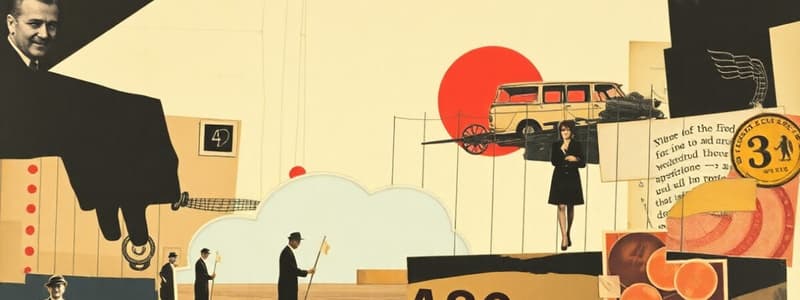Podcast
Questions and Answers
Art is a means through which we can reach out to others for ______.
Art is a means through which we can reach out to others for ______.
mutuality
According to Lankford, art is valued for its emotional impact and its usefulness in ______.
According to Lankford, art is valued for its emotional impact and its usefulness in ______.
social criticism
Art objectifies subjective values and emotions by making them more sensuously ______.
Art objectifies subjective values and emotions by making them more sensuously ______.
tangible
Art enhances celebration and ritual in human ______.
Art enhances celebration and ritual in human ______.
Art helps to stabilize cultures by perpetuating culture members' convictions of ______.
Art helps to stabilize cultures by perpetuating culture members' convictions of ______.
Becker asserts that art involves all those people and organizations whose activities are necessary to produce the kinds of events and objects that a particular group defines as _____ .
Becker asserts that art involves all those people and organizations whose activities are necessary to produce the kinds of events and objects that a particular group defines as _____ .
According to Berger, the owning of art can have a special correlation to social _____ .
According to Berger, the owning of art can have a special correlation to social _____ .
Bourdieu studied the use of art as a form of cultural _____ .
Bourdieu studied the use of art as a form of cultural _____ .
The roles of artists, patrons, and publics need to be studied in different cultures and _____ .
The roles of artists, patrons, and publics need to be studied in different cultures and _____ .
In a culturally diverse society, it is important to ask questions about why we make ______.
In a culturally diverse society, it is important to ask questions about why we make ______.
Art can be used both to perpetuate and to change cultural _____ .
Art can be used both to perpetuate and to change cultural _____ .
The word art can refer to particular works such as paintings, sculptures, and ______.
The word art can refer to particular works such as paintings, sculptures, and ______.
Sociologists of art often focus on the material and social conditions and ______ of art.
Sociologists of art often focus on the material and social conditions and ______ of art.
Judith Blau suggests that understanding the 'peopled' arrangements helps define the matrix of art production and ______.
Judith Blau suggests that understanding the 'peopled' arrangements helps define the matrix of art production and ______.
In a multicultural context, examining how categories function can provide insight into what ______ is for.
In a multicultural context, examining how categories function can provide insight into what ______ is for.
Lukacs, Balfe and Wyszomirski, and Dubin have studied the role of art in cultural ______
Lukacs, Balfe and Wyszomirski, and Dubin have studied the role of art in cultural ______
Art is seen as a powerful force that helps shape our attitudes, beliefs, values, and ______
Art is seen as a powerful force that helps shape our attitudes, beliefs, values, and ______
According to Dissanayake, art reflects or echoes the natural world and is ______
According to Dissanayake, art reflects or echoes the natural world and is ______
Art can temporarily restore the significance and emotional power of ______
Art can temporarily restore the significance and emotional power of ______
Art provides a sense of ______ or significance to human life that cannot be gained in any other way.
Art provides a sense of ______ or significance to human life that cannot be gained in any other way.
Flashcards
Art as a Process
Art as a Process
Art can refer to the method or steps involved in creating something, rather than the finished product.
Culture-Bound Definitions
Culture-Bound Definitions
The way we define and understand art is influenced by our cultural background and perspectives.
What Is Art For?
What Is Art For?
Asking the purpose of art is important, especially in a diverse society, as different cultures have diverse reasons for creating and appreciating art.
Sociological Perspectives on Art
Sociological Perspectives on Art
Signup and view all the flashcards
Art Across Cultures
Art Across Cultures
Signup and view all the flashcards
Art's Social Construction
Art's Social Construction
Signup and view all the flashcards
Artistic Identity
Artistic Identity
Signup and view all the flashcards
Art as Cultural Capital
Art as Cultural Capital
Signup and view all the flashcards
Art and Cultural Values
Art and Cultural Values
Signup and view all the flashcards
Art's Social Impact
Art's Social Impact
Signup and view all the flashcards
Art's Role in Communion
Art's Role in Communion
Signup and view all the flashcards
Art's Impact on Culture
Art's Impact on Culture
Signup and view all the flashcards
Art as Communication
Art as Communication
Signup and view all the flashcards
Art's Objective Functions
Art's Objective Functions
Signup and view all the flashcards
Art's Subjective Functions
Art's Subjective Functions
Signup and view all the flashcards
Art's Reflection of Nature
Art's Reflection of Nature
Signup and view all the flashcards
Art as Therapy
Art as Therapy
Signup and view all the flashcards
Art's Enhanced Perception
Art's Enhanced Perception
Signup and view all the flashcards
Art's Dishabituation Function
Art's Dishabituation Function
Signup and view all the flashcards
Art's Meaning and Significance
Art's Meaning and Significance
Signup and view all the flashcards
Study Notes
What is Art For?
- Art serves many purposes across cultures
- Western culture uses "art" to describe specific works (paintings, symphonies, etc.) or processes or to evaluate a work
- There are many questions about art that continue to be asked: What is art?, What is it for?, What constitutes good art?, Who decides these things?, and By what standards?
- It is important to acknowledge that answers to questions about art are often culture-bound
- One important cultural function of art is to perpetuate, change, and enhance culture.
- Art can be used to create social cohesion and solidarity.
- Art can record and transmit cultural values, beliefs, and stories.
- Art can be a means of social change or protest
- Art can be used to convey meaning about identity, status, and relationships.
- Art is used in a variety of ways across cultures
Finding Unity in Diversity
- In Western culture, the word "art" has various meanings that can be both descriptive or evaluative
- Art can be used to preserve cultural values and pass them on
- Art can be used to challenge or change cultural values
- Art can record and transmit cultural values and beliefs and stories
- Art can serve a purpose of community within a culture.
Studying That Suits You
Use AI to generate personalized quizzes and flashcards to suit your learning preferences.




